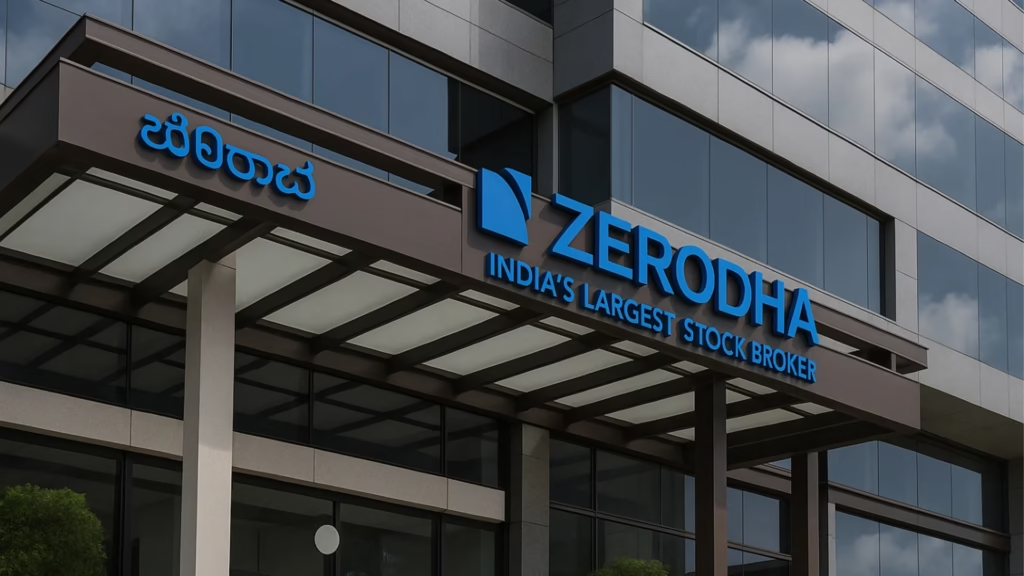When Nithin Kamath started Zerodha trading in 2010, the Indian brokerage industry was a cozy club of traditional firms charging hefty commissions. Opening a trading account meant visiting branch offices, filling endless paperwork, and paying percentages on every trade that ate into profits. For small investors, these costs made trading almost impossible. Buy stocks worth Rs 10,000 and you’d pay Rs 200-500 in brokerage fees. Make ten trades a month and half your profits disappeared into broker pockets. The system was designed for high-net-worth individuals, not regular Indians wanting to invest their savings.
Nithin saw this as broken and fixable. As a teenage trader who’d been in markets since 17, he’d paid these ridiculous fees for years and knew there had to be a better way. The insight was simple: instead of charging percentage-based brokerage that scaled with trade size, charge a flat Rs 20 per trade regardless of amount. Trade Rs 1,000 or Rs 10 lakh, the fee stays Rs 20. For equity delivery, charge zero. This pricing seemed crazy to industry veterans who predicted Zerodha would fail within months. A decade later, Zerodha trading handles 15% of India’s retail trading volume and Nithin Kamath’s net worth exceeds $2 billion. The company achieved this without spending a rupee on advertising, without raising venture capital, and without compromising on service quality. This is how Zerodha made stock trading accessible to millions who were previously locked out of wealth creation.
The Zero Brokerage Revolution
Traditional brokers in 2010 charged 0.5% to 1% brokerage on both buy and sell sides. This meant a single roundtrip trade on Rs 1 lakh worth of stocks cost Rs 1,000 to Rs 2,000 in fees alone. Add exchange charges, STT, GST, and other costs, and you needed stock prices to move 3-4% just to break even. For active traders making multiple trades daily, these costs were devastating. Most retail traders lost money not because of bad decisions but because brokerage ate their profits.
Zerodha trading flipped this model completely. They introduced flat Rs 20 per executed order for intraday and F&O trades, zero brokerage for equity delivery. This pricing was revolutionary and terrifying to competitors. How could anyone survive on such low fees? The answer was volume and technology. By keeping costs low through efficient technology and targeting active traders, Zerodha could profit on high volumes even with minimal per-trade fees. A trader making 100 trades a month paid Zerodha Rs 2,000 but would’ve paid traditional brokers Rs 50,000 or more.
The impact was immediate and massive. Traders who were sitting on the sidelines because of high costs suddenly found trading viable. People who could only afford one or two trades a month could now trade actively. Students and young professionals who wanted to learn trading but couldn’t afford expensive brokers finally had access. Zerodha trading didn’t just compete with existing brokers, they expanded the entire market by making trading accessible to millions who were previously priced out.
Critics said Zerodha’s model was unsustainable, that they’d eventually have to raise prices or cut corners on service. But over a decade later, pricing remains the same while service quality improved. The company proved that when you eliminate intermediary fat and leverage technology efficiently, you can offer better service at a fraction of traditional costs. This forced the entire industry to adapt. Legacy brokers who laughed at Zerodha initially were forced to slash their fees or lose customers. By 2015, discount broking had become the norm, all thanks to Zerodha’s disruption.
Technology That Actually Works
What separated Zerodha trading from competitors wasn’t just pricing, it was technology that traders actually wanted to use. Traditional broker platforms were clunky, slow, and crashed during high volatility when you needed them most. They were designed by IT companies that didn’t understand trading, resulting in complicated interfaces that confused beginners and frustrated experienced traders. Zerodha took a different approach: build technology in-house with traders designing for traders.
Kite, Zerodha’s web and mobile trading platform, became the gold standard for Indian trading apps. The interface was clean, fast, and intuitive. Charts loaded instantly. Order placement took two clicks. Real-time data was accurate. Most importantly, the platform didn’t crash during market volatility when competitors’ systems went down. This reliability built trust that fancy marketing couldn’t buy. Traders knew that when they needed to exit a position during market panic, Kite would work.
Open Source and API Access
Zerodha trading did something unprecedented in Indian finance: they open-sourced their technology and provided free APIs for developers. Kite Connect API let traders build custom trading systems, integrate with their own software, or create algorithmic trading strategies. This attracted tech-savvy traders and developers who built an entire ecosystem around Zerodha’s platform. Third-party apps, trading tools, and analytics platforms emerged, all powered by Zerodha’s APIs.
This open approach seemed risky, why give away your technology advantage? But it created a moat through network effects. Developers building on Zerodha’s platform became locked in. Traders using these third-party tools couldn’t easily switch brokers. The ecosystem strengthened Zerodha’s position rather than weakening it. This was technology strategy borrowed from Silicon Valley applied brilliantly to Indian financial services.
Console and Reporting
Zerodha also built Console, a comprehensive back-office system that gave traders complete transparency into their accounts. Every charge was itemized. P&L was calculated accurately. Tax reports were generated automatically. This transparency contrasted sharply with traditional brokers whose statements were confusing and often hid charges in fine print. Zerodha trading earned trust by showing exactly what traders paid for and removing any mystery around fees or calculations.
Education Before Acquisition
The most overlooked part of Zerodha’s success is Varsity, their free financial education platform. While competitors spent crores on celebrity endorsements and advertisements, Zerodha invested in creating comprehensive educational content teaching everything from basic stock market concepts to advanced options strategies. Varsity modules covered technical analysis, fundamental analysis, risk management, and trading psychology. All content was free, well-written, and actually useful.
This education-first approach had brilliant strategic logic. Most people don’t trade because they don’t understand markets and fear losing money. By educating them first, Zerodha trading created informed traders more likely to succeed and stay active. Happy, profitable traders are the best marketing. They tell friends, post on social media, and become loyal customers. Varsity generated millions of organic leads without spending anything on paid advertising.
Varsity also positioned Zerodha as an authority rather than just a service provider. When people learning about markets did so through Zerodha’s content, the brand became associated with trust and education. New traders who completed Varsity courses naturally opened Zerodha accounts because they’d been learning on that platform. This content moat proved more valuable than any advertising campaign competitors ran.
Community Building
Zerodha fostered trader communities through initiatives like TradingQ&A, a forum where traders helped each other. This peer support reduced customer service costs while building loyalty. Traders who got help from the community felt connected to Zerodha beyond just being customers. They became advocates who defended the brand online and recruited friends. This organic growth through community was sustainable and cost-effective compared to paid acquisition.
The company also maintained radical transparency about their operations. Nithin Kamath regularly posted on social media about Zerodha’s financials, challenges, and decisions. When something went wrong, they acknowledged it publicly. This authenticity built trust in an industry known for opacity and hidden agendas. Traders felt Zerodha was on their side rather than trying to extract maximum fees.
Challenges and Regulatory Scrutiny
Zerodha trading’s rapid growth attracted regulatory attention. SEBI and exchanges scrutinized their practices, concerned about gamification and whether discount brokers were encouraging reckless trading. After the 2020 COVID trading boom saw many retail traders lose money, regulators questioned whether Zerodha and similar platforms made trading too easy, encouraging speculation over investment.
The company faced outages during extreme volatility that frustrated traders. When you’re India’s largest retail broker, any platform issue affects lakhs of people. Zerodha invested heavily in infrastructure but still faced occasional technical problems that damaged reputation. Competitors used these incidents to attack Zerodha on social media, trying to win customers by highlighting service issues.
Competition intensified as Upstox, Groww, and Angel One copied Zerodha’s discount brokerage model. These competitors raised hundreds of millions in venture capital, spending aggressively on advertising to gain market share. Zerodha trading faced pressure to advertise or risk losing customers to better-funded rivals. However, they stuck to their zero-advertising approach, trusting that product quality and word-of-mouth would sustain growth.
New regulations around margin requirements and peak margin penalties increased costs for traders. While these regulations aimed to reduce speculation, they made trading more capital-intensive and complex. Zerodha had to educate customers about changing rules while dealing with reduced trading volumes as some traders exited markets. The company adapted by diversifying into mutual funds, bonds, and insurance distribution, reducing dependence on active trading revenue.
The Path Forward
Zerodha trading is expanding beyond broking into wealth management and asset management. They launched Coin for direct mutual fund investments with zero commissions, disrupting the mutual fund distribution industry the same way they disrupted broking. The platform lets investors buy mutual funds directly without paying distributor commissions that eat 1-2% annually. This saves investors crores while earning Zerodha revenue through optional premium features.
The company is also exploring international expansion, starting with allowing Indian traders to invest in US stocks. This taps into growing interest in global diversification while keeping traders within Zerodha’s ecosystem. Future plans include launching their own mutual funds and PMS services, leveraging the massive customer base they’ve built. Every Zerodha trading client becomes a potential customer for these higher-margin products.
Technology continues to be a focus area. Zerodha is investing in AI-powered trading assistants, better mobile experiences, and tools that help traders make better decisions. The goal isn’t just facilitating trades but helping traders succeed. This aligns with their long-term interest since profitable traders trade more and stay longer.
Nithin Kamath has been vocal about not planning an IPO, preferring to stay private and focused on customers rather than quarterly results. This independence from public market pressures lets Zerodha make long-term decisions that might not maximize short-term profits but build lasting value. Whether they maintain this stance as the business matures remains to be seen, but for now, Zerodha trading enjoys the freedom that comes from being profitable and privately held.
Conclusion
Zerodha trading proved that you don’t need massive advertising budgets, celebrity endorsements, or venture capital to build dominant businesses. What you need is a genuine solution to a real problem, technology that works reliably, and the patience to grow sustainably. By eliminating the biggest barrier to trading, high brokerage fees, and replacing predatory practices with transparency, Zerodha didn’t just disrupt an industry, they expanded it by bringing millions of new participants into markets.
The Zerodha story offers lessons beyond just finance. It shows that bootstrapped businesses can outcompete well-funded rivals when they focus relentlessly on customer value. It demonstrates that education and community building create more sustainable growth than aggressive marketing. It proves that in the age of information, transparency and authenticity matter more than polish and advertising spend. Nithin Kamath built India’s most valuable broking platform not by following the playbook but by tearing it up and writing a new one based on first principles. As more Indians enter financial markets seeking wealth creation, Zerodha trading’s role in democratizing access will be remembered as one of fintech’s great success stories. They didn’t just make trading accessible to millions, they showed those millions that investing in their future is possible, affordable, and within reach.



